SELECTING THE BRAZING PREFORM
In setting down the various preforms available, we may be guilty of too much detail. At the same time, we do want you to have a complete selection. We will go through the variations with illustrations alongside.
MACHINE WOUND RINGS
Ring machines are essentially spring machines. In making a single turn ring, we are merely cutting off the outside turn of a spring. The cutter can be set to cut any amount less than a full turn; it will also cut at any point more than a full turn. This flexibility permits useful variations.
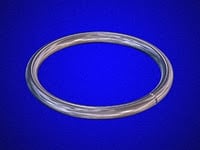 The Butt End Ring. This is the inexpensive, individual ring that covers the great percentage of brazing applications. The ends are butted tightly together to prevent tangling, and ideally, the entire ring lies in one plane with no helix. If the desired I.D. is too small for a given wire size, the ring will take a permanent set in the forming and a partial of full helix will result. If the flatness of the ring is important to the application, the amount of helix permissible should be spelled out on the blueprint.
The Butt End Ring. This is the inexpensive, individual ring that covers the great percentage of brazing applications. The ends are butted tightly together to prevent tangling, and ideally, the entire ring lies in one plane with no helix. If the desired I.D. is too small for a given wire size, the ring will take a permanent set in the forming and a partial of full helix will result. If the flatness of the ring is important to the application, the amount of helix permissible should be spelled out on the blueprint.
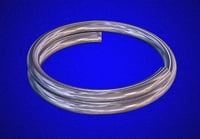 The 1-2/3 turn Ring. This ring is a useful substitute for a full helix single turn ring. A full helix cocks the part and it may not settle evenly when the ring melts. A 1-2/3 turn ring of smaller wire will yield the same volume of alloy; it supports the part on a much flatter surface and the displacement is less.
The 1-2/3 turn Ring. This ring is a useful substitute for a full helix single turn ring. A full helix cocks the part and it may not settle evenly when the ring melts. A 1-2/3 turn ring of smaller wire will yield the same volume of alloy; it supports the part on a much flatter surface and the displacement is less.
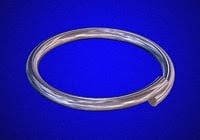 The 1·1/16 turn O.D. Ring. When it is desired to compress a ring inside a tube, as in bicycle frame joints or metal furniture, the 1-1/16 turn ring is a simple method for letting the ends slide past each other. The ring will automatically adjust to variations of the tube I.D. and to any weld seam that may be present. The O.D. is normally specified .010” larger than the nominal I.D. of the tube.
The 1·1/16 turn O.D. Ring. When it is desired to compress a ring inside a tube, as in bicycle frame joints or metal furniture, the 1-1/16 turn ring is a simple method for letting the ends slide past each other. The ring will automatically adjust to variations of the tube I.D. and to any weld seam that may be present. The O.D. is normally specified .010” larger than the nominal I.D. of the tube.
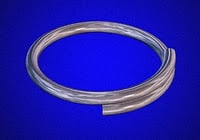 The 1-1/4 turn Ring. The ends of an exposed ring tend to melt first and draw back. With sluggish alloys, such as Easy-Flo 3 or Easy-Flo 35, this sometimes creates an opening that does not refill when the entire ring is molten. It seldom causes a leaker but a cavity or recess that is suspect. By using a ring with overlapped ends, when the ends start to melt, they weld together. This maintains the desired 360° of filler metal. The degree of overlap needed varies with the size of the ring and the term "1-1/4 turn" indicates a type rather than a specific amount of overlap.
The 1-1/4 turn Ring. The ends of an exposed ring tend to melt first and draw back. With sluggish alloys, such as Easy-Flo 3 or Easy-Flo 35, this sometimes creates an opening that does not refill when the entire ring is molten. It seldom causes a leaker but a cavity or recess that is suspect. By using a ring with overlapped ends, when the ends start to melt, they weld together. This maintains the desired 360° of filler metal. The degree of overlap needed varies with the size of the ring and the term "1-1/4 turn" indicates a type rather than a specific amount of overlap.
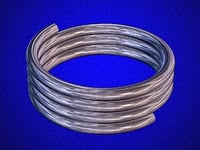 Two or Three turn Rings. Frequently, we are asked for a ring that is too small to form from the desired wire. A two, three, or even five turn ring of a smaller wire may be required to achieve the desired volume. This approach also has merit on pierced joints where a single turn ring tends to flow out on the horizontal surface. The first turn of a multi-turn ring may flow out on the horizontal but succeeding turns will wet to the tube and run down to the joint. Multi-turn rings have many applications on capillary tubes where a fillet is desired to prevent breaking of the tube at the joint seam; also on narrow ledges where a larger wire extends beyond the ledge and on melting rolls over the ledge and drips down the outside.
Two or Three turn Rings. Frequently, we are asked for a ring that is too small to form from the desired wire. A two, three, or even five turn ring of a smaller wire may be required to achieve the desired volume. This approach also has merit on pierced joints where a single turn ring tends to flow out on the horizontal surface. The first turn of a multi-turn ring may flow out on the horizontal but succeeding turns will wet to the tube and run down to the joint. Multi-turn rings have many applications on capillary tubes where a fillet is desired to prevent breaking of the tube at the joint seam; also on narrow ledges where a larger wire extends beyond the ledge and on melting rolls over the ledge and drips down the outside.
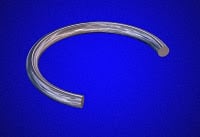 Arc Rings. When a groove is desired, as when a gear fits midway on a shaft, a butt end ring will often distort in going over the shaft and will not snap into the groove. A 220/250 degree arc ring can be pushed into the groove from the side. Arc rings are also useful whenever threads or other obstructions make assembly difficult. Very fluid filler metals such as copper or Easy-Flo 45 will pull around the rest of the periphery by capillary action.
Arc Rings. When a groove is desired, as when a gear fits midway on a shaft, a butt end ring will often distort in going over the shaft and will not snap into the groove. A 220/250 degree arc ring can be pushed into the groove from the side. Arc rings are also useful whenever threads or other obstructions make assembly difficult. Very fluid filler metals such as copper or Easy-Flo 45 will pull around the rest of the periphery by capillary action.
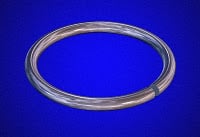 Gap Rings. A gap ring is a somewhat troublesome arc ring. The gap creates a tangling condition and the rings must be spun onto tubes to prevent it. However, when you need to compress the ring and cannot stand a helix, there is no substitute. It is helpful to know exactly how the ring is to be used so that we can vary our manufacturing to your requirements.
Gap Rings. A gap ring is a somewhat troublesome arc ring. The gap creates a tangling condition and the rings must be spun onto tubes to prevent it. However, when you need to compress the ring and cannot stand a helix, there is no substitute. It is helpful to know exactly how the ring is to be used so that we can vary our manufacturing to your requirements.
OTHER WIRE PREFORMS
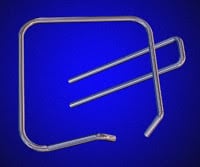 Multislide Parts. The most versatile wire and strip formers are the multislide machines. Rings that are too small in diameter for ring machines to form without a helix can be so formed by multislides. Irregular shapes such as channels, rectangles, hairpins and U clips present no problems. Special shapes lying in more than one plane can be multislide formed. The only disadvantage is the need for tooling that may rule out short-run jobs. The tooling, once paid for, is maintained at our expense.
Multislide Parts. The most versatile wire and strip formers are the multislide machines. Rings that are too small in diameter for ring machines to form without a helix can be so formed by multislides. Irregular shapes such as channels, rectangles, hairpins and U clips present no problems. Special shapes lying in more than one plane can be multislide formed. The only disadvantage is the need for tooling that may rule out short-run jobs. The tooling, once paid for, is maintained at our expense.
 Slugs or Straight Lengths. With the trend toward automation, preforms that can be fed to the parts are finding increased use. We are making slugs .025 long from .025 wire and slugs 5/8" long by .182 wire. If the slug's tendency to roll is undesirable, the wire can be flattened slightly prior to cutting. There is almost no limit to the length and straightness of round and flat wire lengths. Fine-silver lead wires for electronic devices, long flat wire lengths for sighting ribs on shotguns, round wire lengths to slide into broached grooves in sleeves are typical applications.
Slugs or Straight Lengths. With the trend toward automation, preforms that can be fed to the parts are finding increased use. We are making slugs .025 long from .025 wire and slugs 5/8" long by .182 wire. If the slug's tendency to roll is undesirable, the wire can be flattened slightly prior to cutting. There is almost no limit to the length and straightness of round and flat wire lengths. Fine-silver lead wires for electronic devices, long flat wire lengths for sighting ribs on shotguns, round wire lengths to slide into broached grooves in sleeves are typical applications.
WASHERS AND OTHER THIN GAUGE PREFORMS
While rings and other wire forms continue to be the most widely used brazing preforms, recent years have seen an increasing use of washers, discs, shims, and other flat shapes. Part of this increase can be attributed to the rise of the electronics industry where most of the brazing is done in atmosphere furnaces without flux. Components are·light and therefore permit only minimum displacement; the slower heating cycles increase the alloying and inhibit the flow; many components have irregular shapes that can only be matched by blanking.
 BLANKED WASHERS
BLANKED WASHERS
Normal range .0015 to .010 thick.
Blanked washers are produced from strip, usually with compound dies. Below .0015” thickness, the washers wrinkle and burrs become a problem; above .010” thick the scrap generated becomes costly and a coined or edgewound washer is a cheaper solution. Within the range, there is a tremendous demand for blanked washers and we are rolling our own strip to supply the exact thickness desired from the wide range of alloys now in use. We have literally thousands of stock dies available to fit most requirements up to one inch O.D. and we have compound die capability to 4 inches. As brazing washers are to be melted, the I.D., O.D., and thickness can be varied to take advantage of a stock die, and the capillary flow of the alloy will take care of the variance.
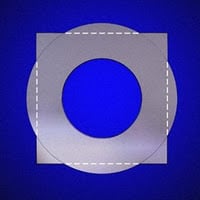 SQUARE AND RECTANGULAR WASHERS Whenever the O.D. is not confined, a square washer can be substituted for a round O.D. We produce these without edge scrap at a considerable saving. Similarly, rectangular washers with one or more holes are blanked with no edge scrap.
SQUARE AND RECTANGULAR WASHERS Whenever the O.D. is not confined, a square washer can be substituted for a round O.D. We produce these without edge scrap at a considerable saving. Similarly, rectangular washers with one or more holes are blanked with no edge scrap.
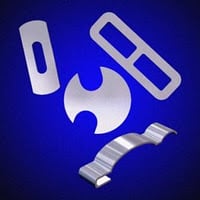 IRREGULAR BLANKED SHAPES Ovals, rectangles, irregular shapes. These are produced on both compound and progressive dies. Since preforms melt and flow, it is not necessary to conform the preform to-every convolution of the assembly. Sharp comers should be avoided at both LD. and O.D. as these create burrs in the blanking. A radius of .010/.020" is sufficient to correct the problem.
IRREGULAR BLANKED SHAPES Ovals, rectangles, irregular shapes. These are produced on both compound and progressive dies. Since preforms melt and flow, it is not necessary to conform the preform to-every convolution of the assembly. Sharp comers should be avoided at both LD. and O.D. as these create burrs in the blanking. A radius of .010/.020" is sufficient to correct the problem.
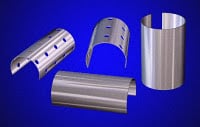 CURVED SHIMS-PLAIN or PERFORATED There are many saddle joints and other tubing joints that are more easily preformed with a curved shim than with a ring. We curve the shim so that the I.D. matches the radius of your tubing. The shim can be formed into a complete circle or any degree of arc. Usually, more than 1800 is preferred so that the shim will snap and hold where it is placed. Curved shims are available in either plain or perforated strip. Perforated shims permit fluxing one component of the assembly and the flux passes through the perforations to flux the other component. Also, the perforations create a chimney effect inside the assembly, speeding the heating of both components.
CURVED SHIMS-PLAIN or PERFORATED There are many saddle joints and other tubing joints that are more easily preformed with a curved shim than with a ring. We curve the shim so that the I.D. matches the radius of your tubing. The shim can be formed into a complete circle or any degree of arc. Usually, more than 1800 is preferred so that the shim will snap and hold where it is placed. Curved shims are available in either plain or perforated strip. Perforated shims permit fluxing one component of the assembly and the flux passes through the perforations to flux the other component. Also, the perforations create a chimney effect inside the assembly, speeding the heating of both components.
EDGEWOUND AND COINED WASHERS
There are many applications for a washer, but often the cost of a blanked washer is prohibitive. The edgewound washer is made by winding flat wire on edge; thus no scrap is generated and no tooling is required. This brings its cost very close to that of a ring.
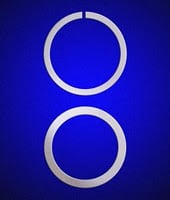 EDGEWOUND WASHERS The edgewound washer comes into its own on the larger diameter and thicker washers where the absence of scrap is the big factor. In the winding process, we are stretching the O.D. and compressing the I.D. It is, therefore, limited to rather narrow webs. This is not a severe limitation as most brazing applications involve shoulders, tubing walls, or other relatively narrow sections. Also, since a brazing preform is to be melted, we can substitute a narrower and thicker washer for a thin blanked washer and the flow of the alloy will take care of the joint. Our first consideration then is to establish the volume of alloy required and produce that volume within the edgewound's limitations. If an application is using a ½” I.D. x ¾” O.D. x .010 thick washer, an edgewound ½” I.D. x .690 O.D. x .015 thick will supply the same volume at lower cost. A 1-1/2” O.D. x 1-1/4” I.D. x .005 thick could be replaced by a 1-1/2” O.D. x 1-3/8”I.D. x .012 thick. The heavier the thickness and larger the diameters, the greater the savings. We do need to know which is the critical diameter, I.D. or O.D., in order to fit the part.
EDGEWOUND WASHERS The edgewound washer comes into its own on the larger diameter and thicker washers where the absence of scrap is the big factor. In the winding process, we are stretching the O.D. and compressing the I.D. It is, therefore, limited to rather narrow webs. This is not a severe limitation as most brazing applications involve shoulders, tubing walls, or other relatively narrow sections. Also, since a brazing preform is to be melted, we can substitute a narrower and thicker washer for a thin blanked washer and the flow of the alloy will take care of the joint. Our first consideration then is to establish the volume of alloy required and produce that volume within the edgewound's limitations. If an application is using a ½” I.D. x ¾” O.D. x .010 thick washer, an edgewound ½” I.D. x .690 O.D. x .015 thick will supply the same volume at lower cost. A 1-1/2” O.D. x 1-1/4” I.D. x .005 thick could be replaced by a 1-1/2” O.D. x 1-3/8”I.D. x .012 thick. The heavier the thickness and larger the diameters, the greater the savings. We do need to know which is the critical diameter, I.D. or O.D., in order to fit the part.
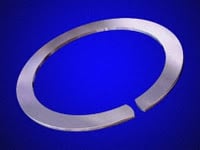 COINED WASHERS In the smaller size washers below 1 inch, we cannot always edgewind as large a volume as is desired, or we may not be able to get it as thin as desired. In this situation we can produce a coined washer by forming a ring and flattening it between steel platens. It has the same virtues as the edgewound, no dies and no scrap and it is absolutely flat .
COINED WASHERS In the smaller size washers below 1 inch, we cannot always edgewind as large a volume as is desired, or we may not be able to get it as thin as desired. In this situation we can produce a coined washer by forming a ring and flattening it between steel platens. It has the same virtues as the edgewound, no dies and no scrap and it is absolutely flat .

